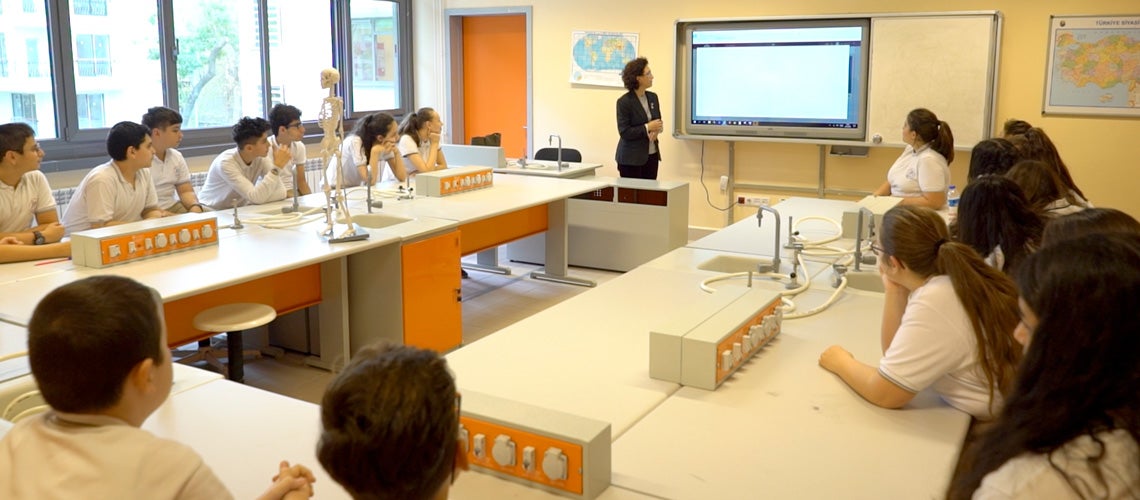 Kids in Turkey attending their lesson
Kids in Turkey attending their lesson
Is the ‘middle-income trap’ myth or reality? The World Bank’s 2020 Human Capital Index (HCI) report offers new analysis on the distribution of learning and health outcomes, and what they mean for long-term earnings, from low- to high-income countries. Looking at the data, it may seem that middle-income countries could be prone to getting stuck in the middle without boosting key human capital dimensions. The outbreak of the novel coronavirus (Covid-19) this year is exacerbating this challenge. Yet some countries have managed to avoid the trap. How you invest matters.
Take Turkey. The 2020 HCI score for Turkey is 0.65, above the global average of 0.56 and a hairline below where most middle-income countries sit, somewhere between 0.63 and 0.70. The score implies that a child born today in Turkey is expected, all else held equal, to reach 65 percent of his/her full economic (earnings) potential as an adult.
Turkey’s HCI-utilization rate, which measures the child’s ability to find employment as an adult, shows that the share of the labor force that is employed declined from 47 percent in 2018 to 42 percent by mid-2020. Though the underlying factors are complex, labor’s share of national income is generally higher for countries with a higher HCI score, with Turkey showing a relatively lower labor income share for its level of HCI (figure below). Skills play a big role. Decomposing the HCI into its individual factors shows that learning outcomes in Turkey lag behind other comparable countries to a greater extent than do health outcomes used in the index.
Human capital is closely correlated with labor income as a share of GDP among 162 countries.
Source: Author, using World Bank Human Capital Index Database, 2020 (human capital index), and ILOSTAT (labor income as a share of GDP), International Labor Organization.
While gender differences in HCI are limited, female labor force participation and employment rates are 50 percent below the rates for males, making Turkey an outlier among comparators. HCI by socioeconomic status also mimics the distribution of labor income across income groups, which is 30 times higher among the wealthiest, compared to the poorest. Driven by educational differences, these gaps reflect not only gaps in foundational skills like literacy, math and science, but also higher-order cognitive and non-cognitive skills like innovation, perseverance and problem-solving, skills which are more difficult to substitute with capital in times of shocks to labor demand.
Turkey’s investment in education has changed over time towards a more competitive, knowledge-based economy, in line with national development plans. During 2000 to 2016, public expenditure on primary and secondary education increased modestly, reaching nearly 2.5 percent of GDP at the end of that period. This is towards the lower end of spending among Organization for Economic Cooperation and Development (OECD) and middle-income countries. During the same time, spending on tertiary education shot up considerably, especially after 2008, reaching 1.2 percent of GDP. This put Turkey among the top third of spenders among OECD and middle-income countries, from the bottom third. Yet labor outcomes have not changed significantly since 2008, calling into question the relative returns to human capital outcomes not just of levels of spending, but the nature of spending as well.
To respond to these challenges, compounded as a result of the Covid-19 outbreak, Turkey has accelerated efforts to escape the middle-income trap. The Turkey Safe Schooling and Distance Learning Project, supporting the Government’s Education Roadmap Vision 2030, steps up investments in digital curricula and learning modalities to expand access to online education and the skills required during and after Covid-19, targeting lower-income households and girls’ education.
The Turkey Formal Employment Creation Project is likewise aiming to narrow the gap between access to finance and employment by incentivizing firms to invest in human capital through labor-intensive measures, particularly aimed at youth and women. Strengthening on-the-job training and more robustly evaluating the evolving demand for occupational and socio-emotional skills has been underway by the Ministry of Family, Labor and Social Services and the national employment agency, ISKUR. Better preparing youth and adults for the labor market helps to boost returns to human capital among adults and their children. Going forward, expanding while rethinking education and jobs investments is key to improving labor productivity in Turkey and elsewhere.



Join the Conversation